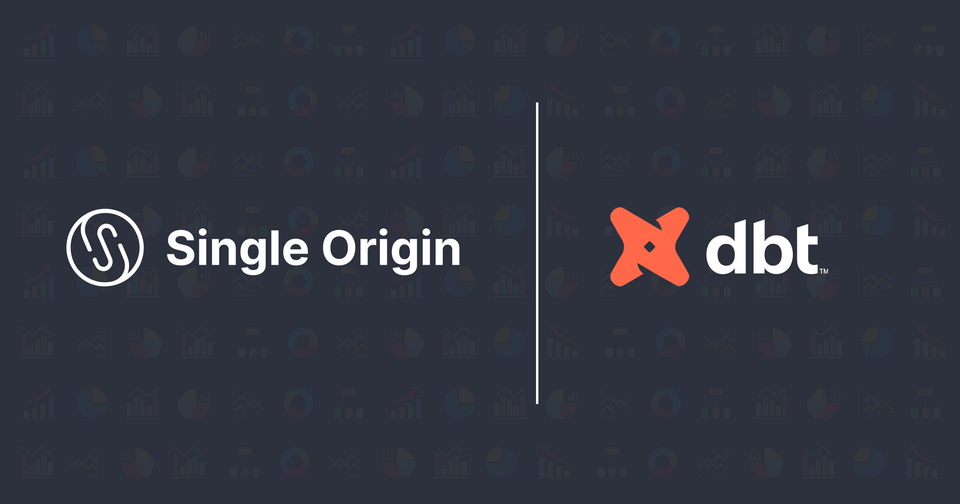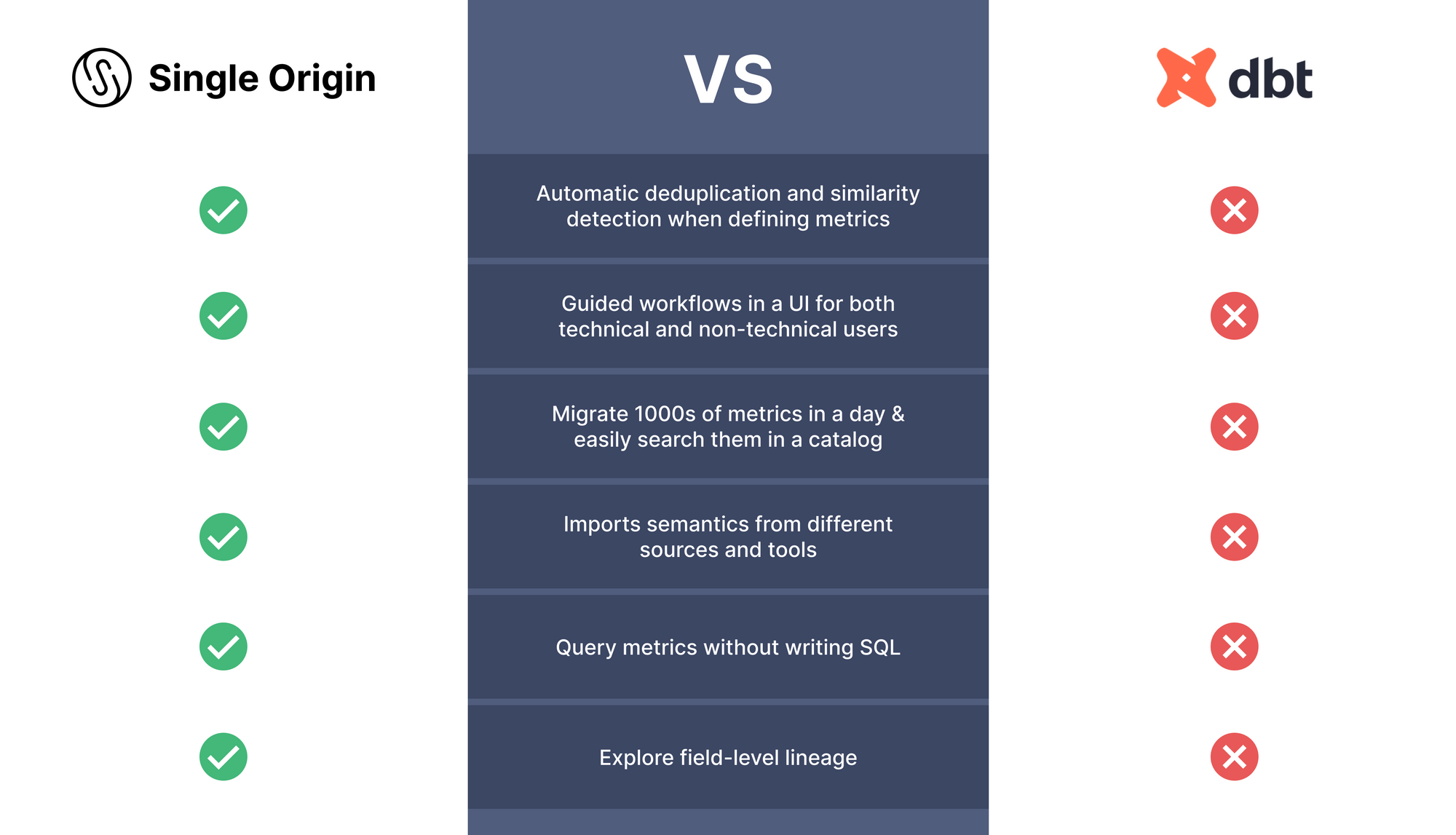5 Reasons to adopt Single Origin Semantic Management over DBT

Managing the quality and consistency of your data pipelines and analytics has never been more challenging - or more critical. Data organizations grow in complexity every day. This complexity makes collaborating across your organization or scaling your operations difficult. The dream of simplifying and refining your data platform may feel like a mirage, always in the distance. Luckily, a new paradigm is forming around the semantic layer. By managing your SQL semantics, you can improve quality and consistency. With the right semantic management tool, you can even unlock collaboration, scalability, and higher-quality analytics.
In our recent series of blog posts, we’ve discussed how Single Origin brings all of these benefits and more to users. Today, we will examine how Single Origin compares to a new tool from dbt - the dbt Semantic Layer. Let’s now explore five ways Single Origin exceeds the features offered by dbt.

1. Single Origin goes from zero to value in under 5 minutes
To demonstrate this, let’s compare an example workflow with dbt and Single Origin. Suppose you want to create your first metric.
With dbt’s Semantic Layer, you would need to:
- Decide what layer to define your metric in
- Decide on the new folder and file structure you want to use for your metric
- Define the metric in a YAML file with Jinja and macros on top of SQL. While the structure of this file is simple, it requires users to learn the tools and write out every desired field/column.
- Merge this YAML file into your codebase
Once you complete these steps, you can finally query your new metric… by writing non-standard SQL syntax that references your metric.
In Single Origin, you would need to:
- Copy a SQL query for your metric into our interactive import flow
- Click import & add a name and description.
No YAML to write and maintain, no manually writing out fields and columns. It’s that simple. Your metric is now added to a searchable catalog in a UI that includes field-level lineage and usage metrics. You can search for and use your query immediately.
2. Single Origin scales without growing pains
Let’s now imagine you don’t have one metric to create but 100. Instead of defining each metric by hand in a YAML, you can run a batch import in Single Origin to import all 100 metrics at once. Because Single Origin automatically builds a catalog of your metrics, you get an organized repository immediately. You don’t have to decide what layer each metric is defined in or update folders and file structures. It’s just there, ready to be consumed and incorporated into your data ecosystem.
Single Origin automates semantic management, while dbt relies on manual user input to do the same tasks. For example, using dbt’s Semantic Layer:
- If a user updates a model to add a new column, then the user needs to add the new column to the metric as well.
- If a user updates a model to remove a column, then the user needs to know that the metric needs to be updated as well; otherwise, the metric will break in production.
Single Origin links the concepts of views and metrics directly, enabling the platform to validate changes to metrics with no human input. This automation makes scaling from 1 to 100 to 1000 semantics a breeze.
Users aren’t likely to write definition after definition by hand and then manually manage any changes to upstream or downstream resources. That’s downright painful. If you don’t put in the effort, however, your semantic management tool is useless. That is why ease of use is a priority in Single Origin - maintenance is necessary to experience the benefits of semantic management. Single Origin makes the maintenance experience as seamless and automated as possible.
3. Single Origin unlocks company-wide collaboration
One exciting potential benefit of semantic management is collaboration. Once your metrics are defined, it doesn’t matter if it is Jerry in accounting or Sheila in analytics; everyone works with the same metric definitions. Organizational data silos can become a thing of the past with a unified data Lingua Franca.
In Single Origin, collaboration is a top priority. Single Origin’s interface is designed for engineers and non-engineers alike. While dbt’s semantic layer may be useful for the technologically savvy, Single Origin prioritizes usability at all levels of technological know-how. Once your imports are complete, you can query new metrics immediately via our UI - no need to write SQL if you don’t want to. Whether you’re a casual consumer of data or an advanced ML engineer, Single Origin gives you sophistication when you need it and simplicity when you don’t.
4. Single Origin reduces redundancies and improves the quality of your metrics and analytics
When a data organization expands, the number of queries and pipelines grows with it. Inevitably, redundant queries appear. Worse still, similar (but substantively different) queries may be used to derive the same metric.
Single Origin allows you to identify similar and duplicate queries with the click of a button using a query audit feature. With these insights, you can cull duplication and align data consumption to ensure consistency and quality in your data analytics. Dbt’s Semantic Layer offers no such advantage. Additionally, dbt’s Semantic Layer relies on runtime errors to discover invalid SQL. Single Origin verifies and validates SQL when it’s added into the semantic management system before runtime. This makes the job of a data operator easier, meaning consumers never have to worry about invalid SQL queries. Ultimately, would you rather discover a major blocker to your mission-critical data analytics at runtime or when you define your metric?
5. Single Origin collects metadata on your metrics and usage
Hidden within your organization’s querying behavior is a wealth of information that Single Origin can uncover for you. Users can leverage these insights to improve operational efficiency and transparency in your data organization. For example, Single Origin tracks who is querying what metrics, enabling compliance teams to focus on the most popular metrics. Query auditing simplifies tracking down who is doing what with your organization’s data. Or imagine you’re a data operator who needs to know how a metric definition came to be. With field-level lineage, Single Origin enables data operators to understand how particular metrics are derived and who defined them. Usage metrics gathered by Single Origin are also used to improve search results, allowing data operators to find what matters faster.
The possibilities are endless. And it’s all accessible anywhere - both inside Single Origin and via Single Origin’s API. Dbt’s Semantic Layer does not provide users with this level of insight.
Bonus: Single Origin requires fewer integrations
When it comes to integrations, dbt has a lot of partnerships that make it easy to add field-level lineage, catalogs, or interactive, no-code querying to your metrics. While each integration may be easy, you could find yourself paying for multiple tools & constantly having users log in and switch between different apps. Single Origin offers much of this functionality in a single platform, from a semantic layer to a catalog to lineage, quality, and querying.
To recap, Single Origin provides significant advantages compared to dbt’s semantic layer platform. These advantages come from leveraging usability, automation, and semantic analysis. Check out our other blog posts if you’d like to learn more about how Single Origin works under the hood. If you’re interested in how Single Origin can transform your semantic layer, then email us.

